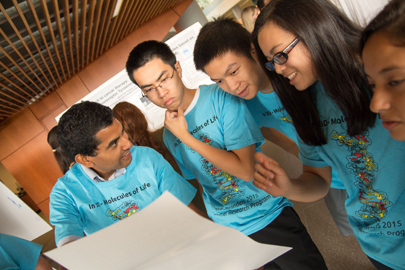SciFest showcases young scientists with bold ideas
Undergraduate and high school students relish opportunity to conduct and present hands-on scientific research.
 Photos/Ian Roy
Photos/Ian RoySix Waltham High School students worked with professor Daniel Pomeranz Krummel
Most young, aspiring scientists can only dream about having the opportunity to test a hypothesis with rigorous laboratory study. That dream became a reality for nearly 100 undergraduate and high school students who were selected to conduct research at Brandeis this summer.
The students, who worked alongside faculty, graduate students and postdoctoral fellows as they conducted their research, presented their findings to their peers and Brandeis faculty at the SciFest poster session in the Shapiro Science Center atrium on July 30.
“The students work hard in their research, but we worked with them to put together the other skills necessary to succeed in the sciences,” says Anique Olivier-Mason, the director of education, outreach and diversity for the Brandeis Materials Research Science and Engineering Center (MRSEC). “We did various workshops in the summer, the most relevant being a poster development session. Now you see these absolute masterpieces which very nicely convey their research.”
The budding scientists had a wide-range of lab experience and areas of focus. The presentations represented the fields of biology, biochemistry, chemistry, physics, and neuroscience, with most students doing research in a Brandeis science faculty member’s lab with the intention of developing a substantial project for their senior thesis. Two students displayed the results of research from Study Abroad in Denmark and in India, while five students from Bangalore, India journeyed to campus, also in collaboration with the Office of Study Abroad, through the Brandeis-India Scholars Exchange Program.
A unique component to SciFest was that all presenters, regardless of their experience inside a laboratory, took primary responsibility for the direction of their research. SciFest was the culmination of weeks—and sometimes months—of hands-on research that was done with the support and encouragement of Brandeis faculty and staff.
Sarita Biswas ’16, a biology major, and Ayantu Temesgen ’17, a biochemistry major, studied cell proliferation, research that could yield new findings on the development of tumor cells. John Deng ’17 experimented with Naegleria, a genus that includes thousands of protozoa, with the intent to create a genetic “bar code” that in the future could enable the instantaneous identification of a living thing. Ruth Love-Damoah ’17 conducted research of human saliva with the goal of refining a new method of diagnosing tuberculosis.
“I never thought I’d do this,” says Love-Damoah, who majors in biology. “I thought that maybe I’d be in a lab, setting up reactions and doing easy stuff. But this is very significant. The professors give students the opportunity to do their own research at Brandeis. Here, I’m in charge of my own research.”
The summer research program attracted students from beyond Brandeis. Two Research Experience for Undergraduates programs, sponsored by the National Science Foundation, brought 14 visiting students to campus for 10 weeks to participate in research. Additionally, supported by funding from MRSEC and the NSF, six Waltham high school students worked with Daniel Pomeranz Krummel, assistant professor of biochemistry, to learn about physicochemical properties with 3-D technology.
Harsha Gurnani, from Bangalore, came to Brandeis as part of the Khorana Scholars Program and worked with Eve Marder, the Victor and Gwendolyn Beinfield Professor of Neuroscience, on a computational study to understand what kind of homeostatic rule could be used to maintain neuronal functions as neurons grew.
“Harsha was superb,” says Marder. “She integrated herself into the lab and won the respect of everyone here. Hopefully she’ll continue working with us off-line on her research, but this experience was tremendously important as it showed her a new culture and gave her a sense of what it’s like to study in an American institution.
Brandeis summer student researchers were supported by a mixture of research funds to faculty and competitive fellowships. Fellowship competitions were held in the spring, with each student having to submit a short research proposal, which were judged by a faculty panel. These competitions included the Division of Science Summer Undergraduate Research Fellowships, MRSEC Fellowships, Jordan Dreyer (Chemistry) Fellowships, and Computational Neuroscience Traineeships (funded by the National Institutes of Health). Other students received Provost’s Undergraduate Research Fund grants.
“Funds from the M.R. Bauer Foundation, and from alumni and supporters of Brandeis were absolutely instrumental in allowing the Division of Science summer program to run at its current record size”, says Steven Karel, a Division of Science staff member who organized the funding competitions. “Students now plan ahead – they look for labs as freshmen, and start crafting a project so they’ll have a strong proposal for the fellowship competitions”
“SciFest was a huge success this year with 90 students presenting their posters to the Brandeis community,” says Dean of Arts and Sciences Susan Birren. “The excitement and the quality of the science carried out by these undergraduates was inspiring. The great turnout of Brandeis faculty really speaks to the commitment to intensive undergraduate research in faculty laboratories.”
Categories: Alumni, General, Research, Science and Technology, Student Life





